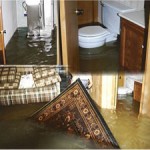Until you’re faced with the harsh reality of the health problems associated with mold growth in the home, you might not think of mold as being as devastating to you as fire or water damage. The truth is, mold is a second-most and even more troublesome invader. Consider the following scenario: Flooding occurs in your home. For the next several days, you work tirelessly to dry out the home – from carpets and walls to furniture and belongings. Once you are no longer walking in standing water, you breathe a sigh of relief. But, if you stop at only what you can see inside your home, you may be breathing in more than just relief – you might be inhaling toxic mold.
 A must for any home that’s encountered water damage
A must for any home that’s encountered water damage
After water damage has occurred in the home mold is often found on walls, floors, ceilings, carpets and fabrics. Mold also can lurk in ductwork and HVAC components – the very mechanisms that circulate air in your home!
When mold is present, spores occur naturally in the air. So your HVAC system will constantly re-circulate the mold spores through the system and the spores will typically settle into areas with dust on the surface. This is the ideal environment for mold to grow; it stays in the dust and continues to propagate.
Don’t wait until you get sick to check for mold
Mold can cause a plethora of health issues: itching eyes, sneezing, coughing, allergic reactions, asthma attacks, and even permanent lung damage – all under the cover of an otherwise spotless home.
Many people don’t become aware of a mold problem until they get sick. But you can take preventive measures instead of waiting until your health is compromised. If you use a professional cleaning restoration company right after flooding to help you remove the water and repair the damage, their professionals will take steps to prevent mold from forming. But if you’ve attempted damage control on your own, make sure you have a mold inspection performed by certified water damage and mold remediation specialists after water damage has occurred to your home. A professional restoration service specializing in mold removal can perform specific tests designed to confirm whether or not you have mold lurking behind the walls and in the ductwork. Such a professional restoration and cleaning service can also best recommend methods of eliminating the health hazard posed by mold.
What if mold is discovered in my home?
If you discover mold in your home, or even if you suspect mold could be present as a result of recent or past water damage, immediately call a mold restoration professional. Consult our Web site, RestorationMasterFinder.com, to find a professional mold remediation service in your area.
Want to know what others think about the mold and mildew removal and remediation professionals in your area? Visit MyCleaningReviews.com for real reviews and recommendations from consumers who have been in your shoes.
Some tips from the EPA on preventing mold:
- Fix leaks and seepage.
- Put a plastic cover over the dirt floor in crawlspaces to prevent moisture from coming in from the ground. Always keep crawlspaces well ventilated.
- Use exhaust fans in bathrooms and kitchens to remove moisture to the outside (not into the attic). Vent your clothes dryer to the outside.
- Turn off certain appliances (such as humidifiers) if you notice moisture on windows and other surfaces.
- Use dehumidifiers and air conditioners, especially in hot, humid climates, to reduce moisture in the air, but clean them regularly or take other measures to be sure that the appliances themselves don’t become sources of biological pollutants.
- Raise the temperature of cold surfaces where moisture condenses. Use insulation or storm windows. A storm window installed on the inside works better than one installed on the outside.
- Open doors between rooms to increase circulation. Circulation carries heat to the cold surfaces.
- Be sure that your house has a source of fresh air and way to expel excessive moisture from the home.
- Pay special attention to carpet on concrete floors. Carpet can absorb moisture and serve as a place for biological pollutants to grow. Use area rugs that can be taken up and washed often.
 A must for any home that’s encountered water damage
A must for any home that’s encountered water damage


